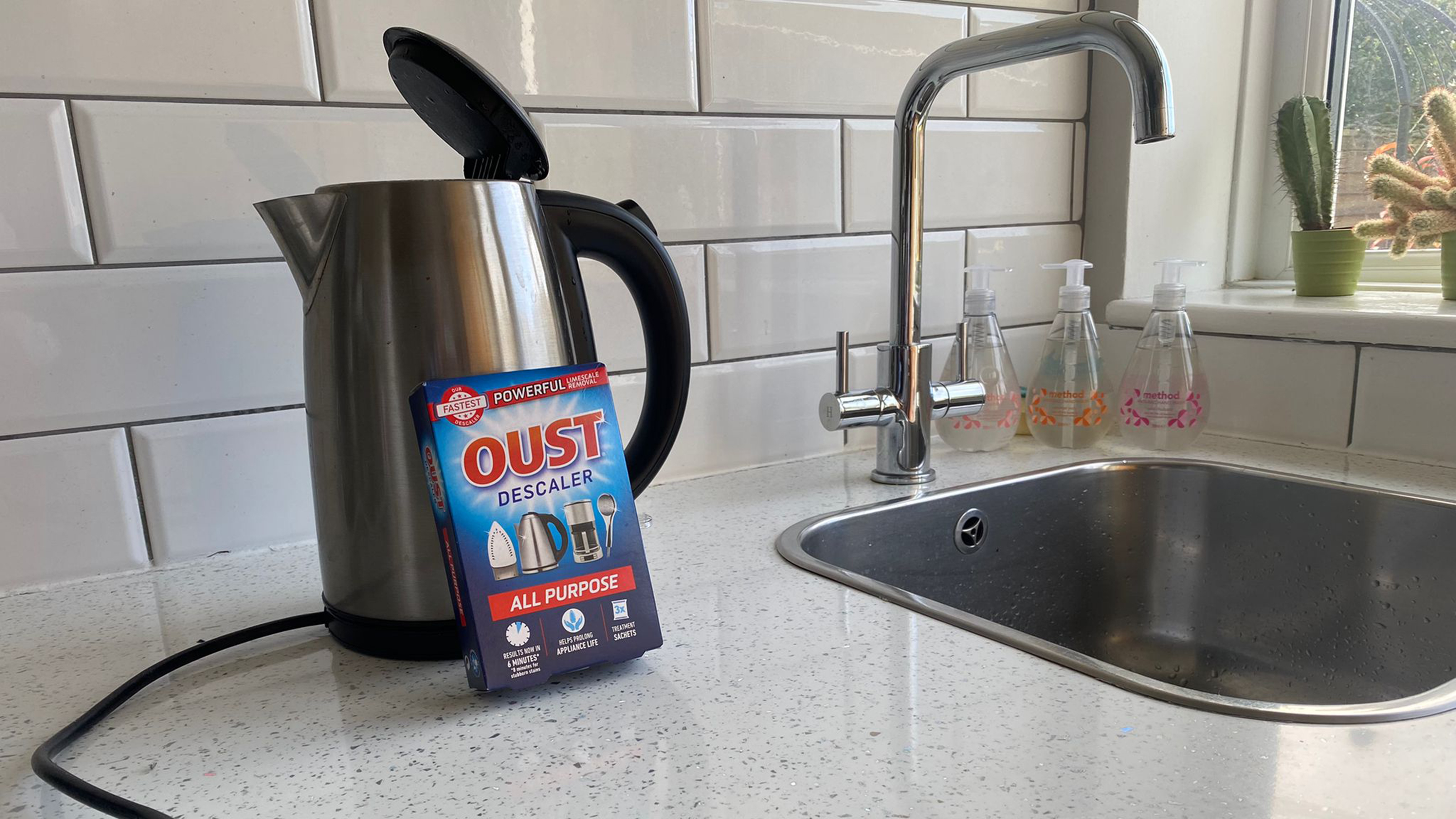
- Good to know
- Here's what you'll need
- How to clean an electric kettle with descaler
- How to descale a kettle with vinegar
- How to clean an electric kettle with lemon juice
- How to descale a kettle with baking soda
- How to descale a kettle with cola
- How to descale a kettle with citric acid
- How to descale a kettle with denture tablets
- FAQs
- Meet our experts

Once upon a time, there was a woman who learned how to clean an electric kettle. That lady was me. For longer than I'd like to admit, I wondered what the floating shards that sat at the bottom of my electric kettle were. I assumed it was down to the water in my area... but that was only half the problem.
Brits will be the first to tell you that nothing ruins a good cup of tea more than getting to the end, only to find that it's filled with flaky bits of limescale. Not what you were expecting, right? Calcium deposits are the numero uno reason to clean an electric kettle regularly, as not only is limescale detrimental to your beverage-drinking experience, but if left too long, it can also shorten the lifespan of your kettle, and ain't nobody got time for that. Plus, working with a caked-up tea kettle uses more energy in order to reach boiling point.
Give me less than 10 minutes, and I'll show you seven ways to clean an electric kettle using storebought solutions and stuff you already have in your cabinets and fridge.
Good to know
Time: 10 minutes
Difficulty: Easy
Helpful tips: The instructions for cleaning an electric kettle depends on the type of machine you have, but there are some general guidelines every electric kettle owner should know. Here, we've used a standard stainless steel kettle to demonstrate, but it's best to consult your instruction manual if you have a glass kettle or if yours has any special features.
Here's what you'll need
- Access to a sink with running water
- Descaling solution — I've used Oust, which you can buy on Amazon
- A non-scratch scouring pad — I like this one from the Scrubit Store on Amazon
- Microfiber cleaning cloths — Amazon Basics always come through for me!
How to clean an electric kettle with descaler
Step 1: Let your appliance cool
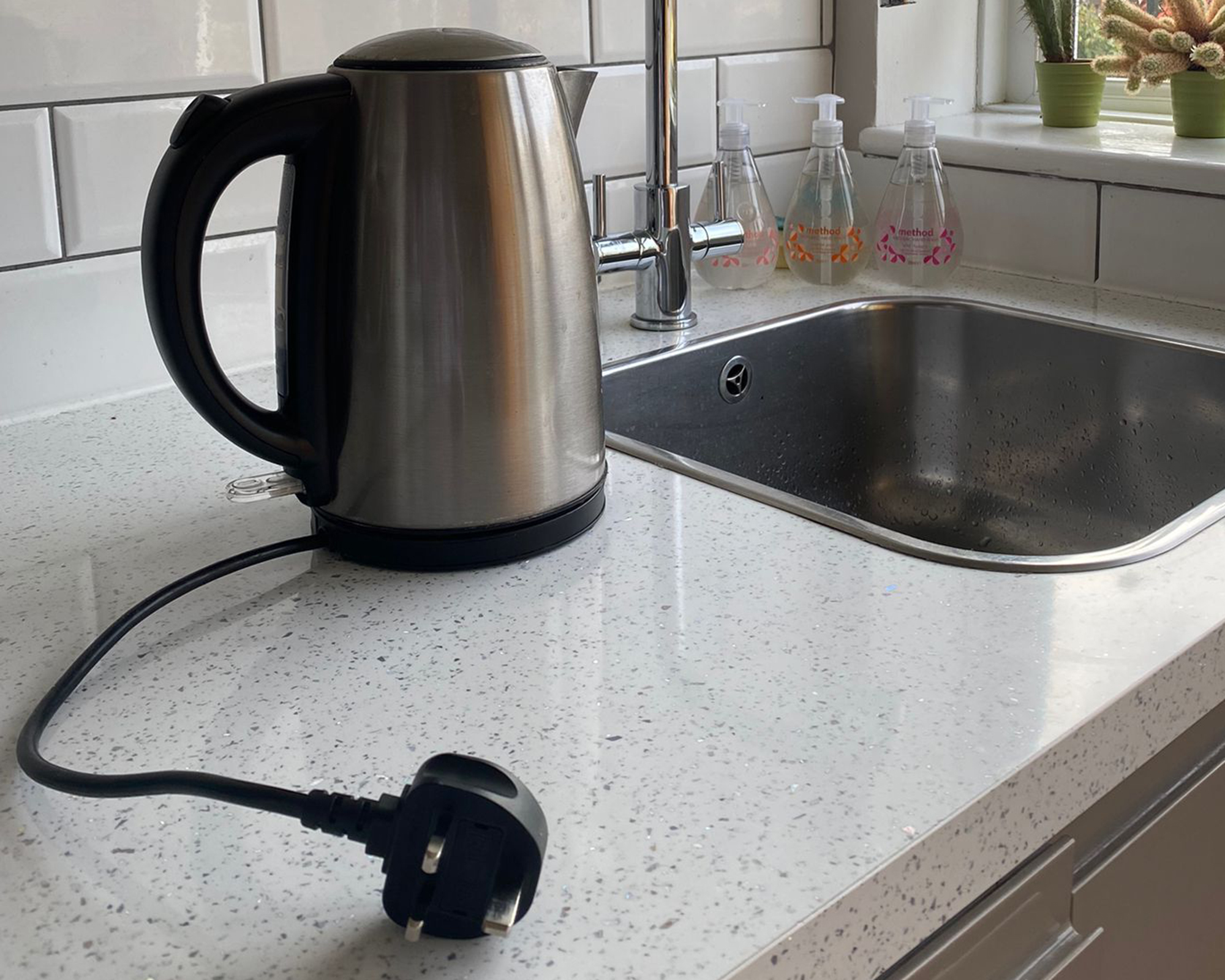
An unplugged electric kettle in kitchen
If you are cleaning the interior or the exterior of the kettle by hand, unplug it and check that it has cooled down before starting.
Step 2: Fill the kettle with water
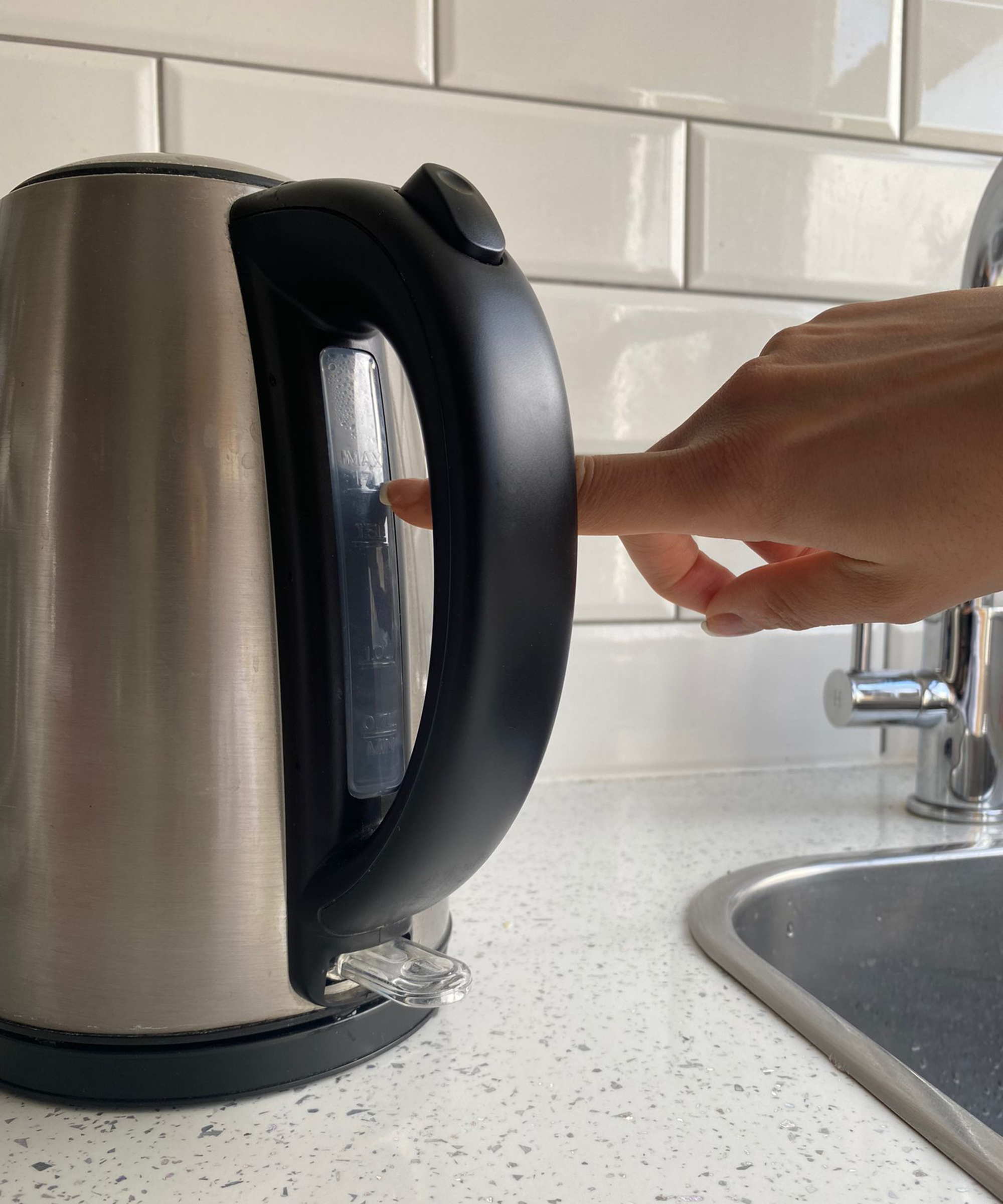
Christina Chrysostomou pointing out max fill line on electric tea kettle in white tiled kitchen
Fill your appliance up to the max line with cold water from the faucet.
WARNING: Watch your electric parts! When you're cleaning your kettle, always take extra care to ensure that the base of the kettle and its electrical parts remain dry.
Step 3: Boil the kettle
Allow the water to cool once it has boiled.
Step 4: Pour in the descaling solution
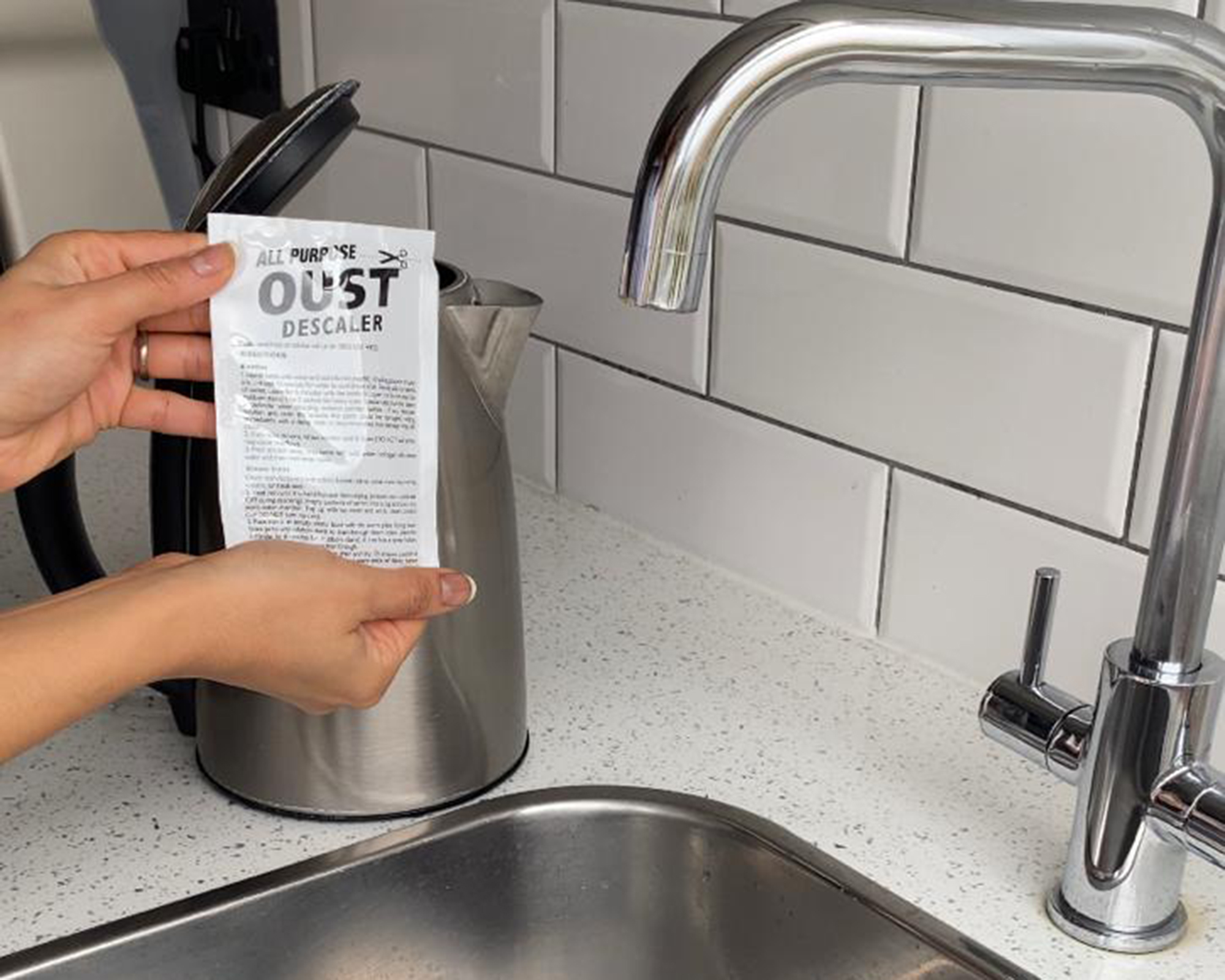
Christina Chrysostomou using sachet of Oust all-purpose descaling treatment to clean an electric kettle
Pour in the descaling liquid (leaving the lid open), and wait approximately 6–8 minutes for the solution to work.
WARNING: Be careful as the boiling water can spit when adding your specialist descaling product.
Step 5: Pour out the solution and rinse
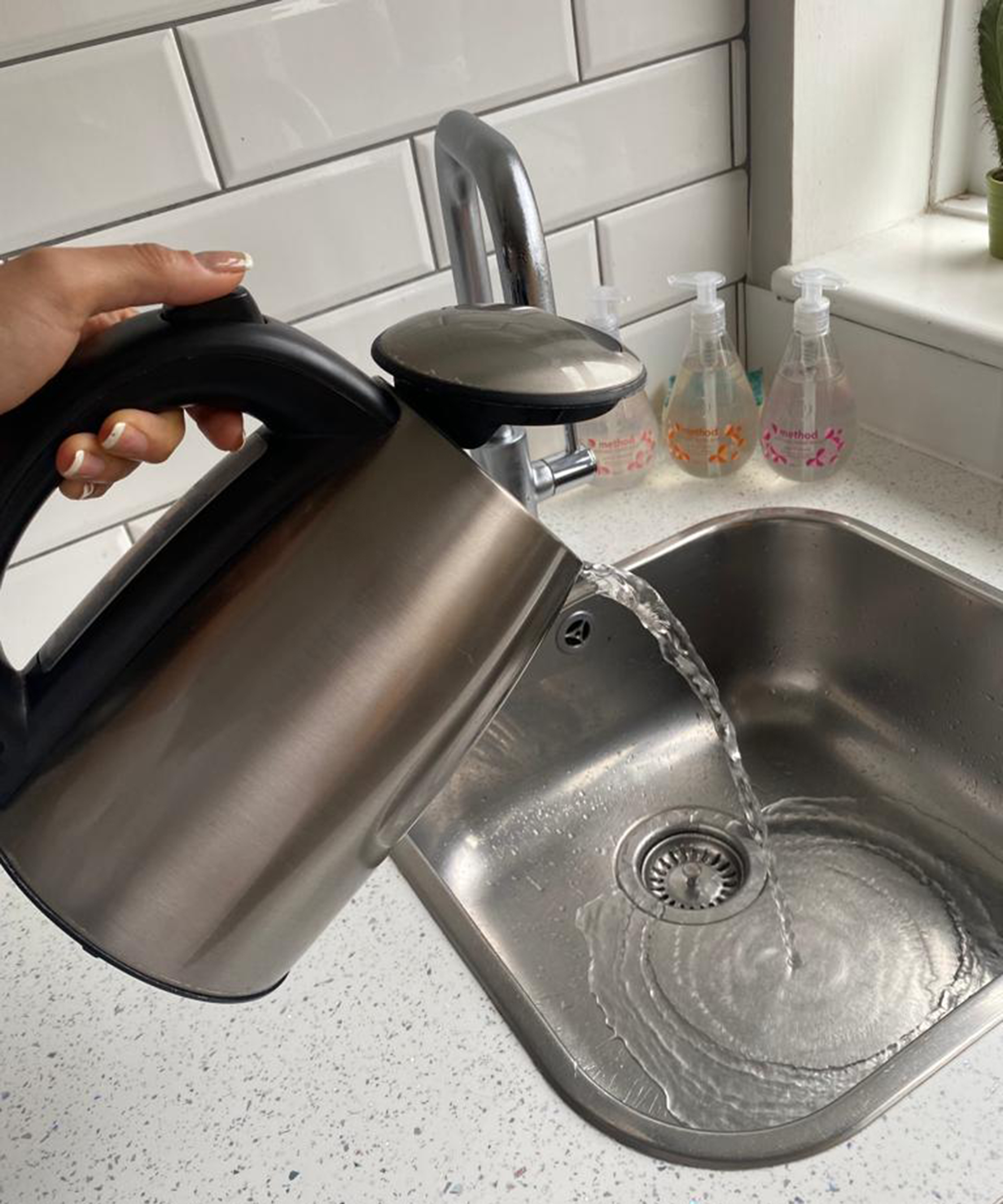
Christina Chrysostomou pouring water from electric kettle down the sink
Discard the solution by pouring it into the sink. Give your kettle a rinse with cold water, fill the kettle again (to the max line), boil again, and get rid of the water down your kitchen sink.
Step 6: Dry with a microfiber cloth
Wait until your kettle has cooled, then dry it (inside and out) with a microfiber cloth.
Step 7: Removing limescale around the lid and spout
If the top of your kettle looks a little crusty, create a thick paste with baking soda ( Arm & Hammer from Amazon is always our go-to) and water and apply to the affected areas. Leave it to harden, then use a toothbrush (or a small cleaning brush like the one in this Oxo set from Amazon) over the sink, to remove it. Rinse with a little water, ensuring again not to get the base wet, and finally dry it with your clean microfiber cloth.
Alternatively, you could give these areas a gentle rub with a non-scratch pan scourer (like you can get in this Amazon pack) to dislodge the last few pieces of limscale. Rinse well afterward and dry.
Products to buy to descale and clean an electric kettle
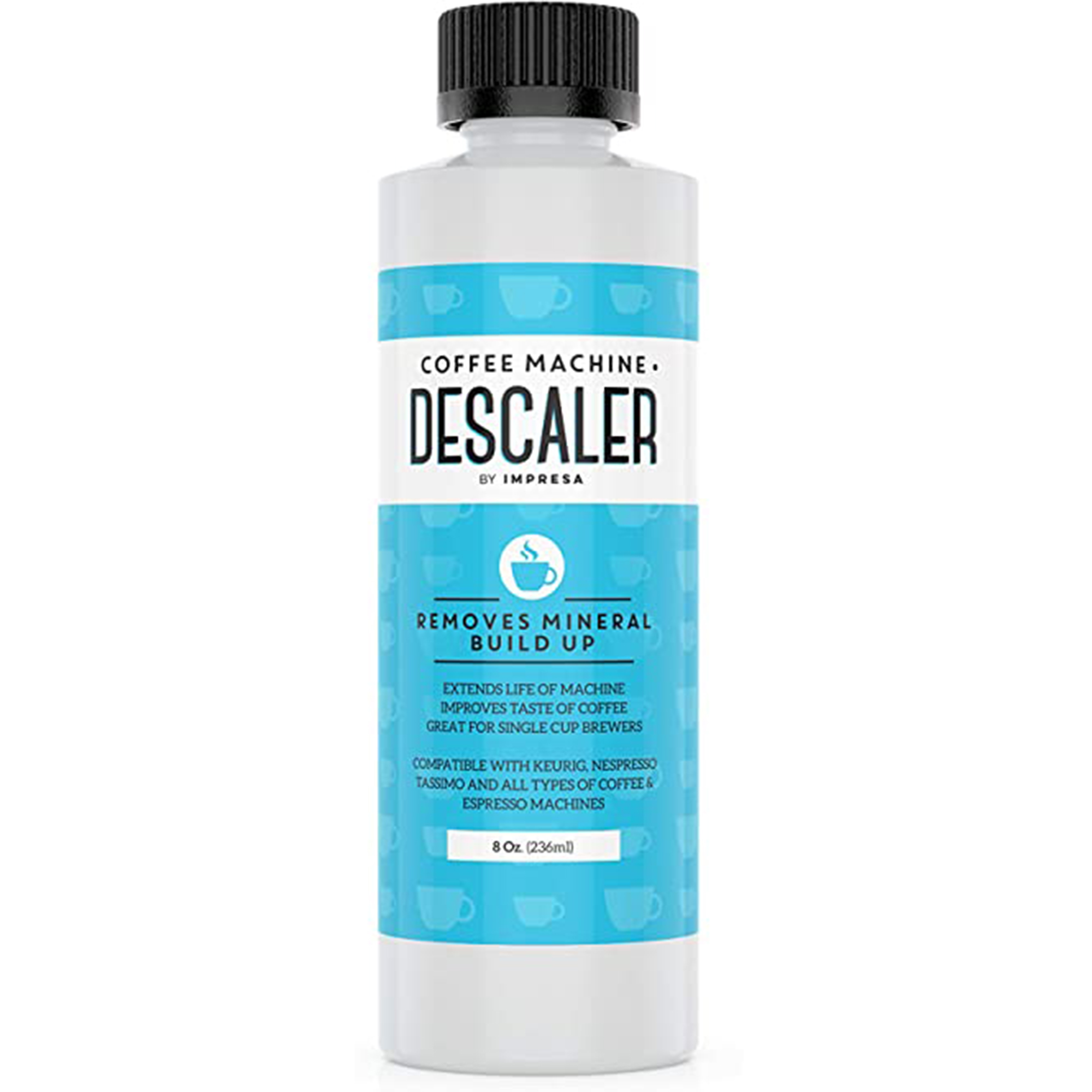
Type: Liquid
Size: 8 fl. oz.
Though marketed as a descaling solution for your coffee machine, this highly-rated Amazon bestseller can also be used to clean an electric kettle, too.
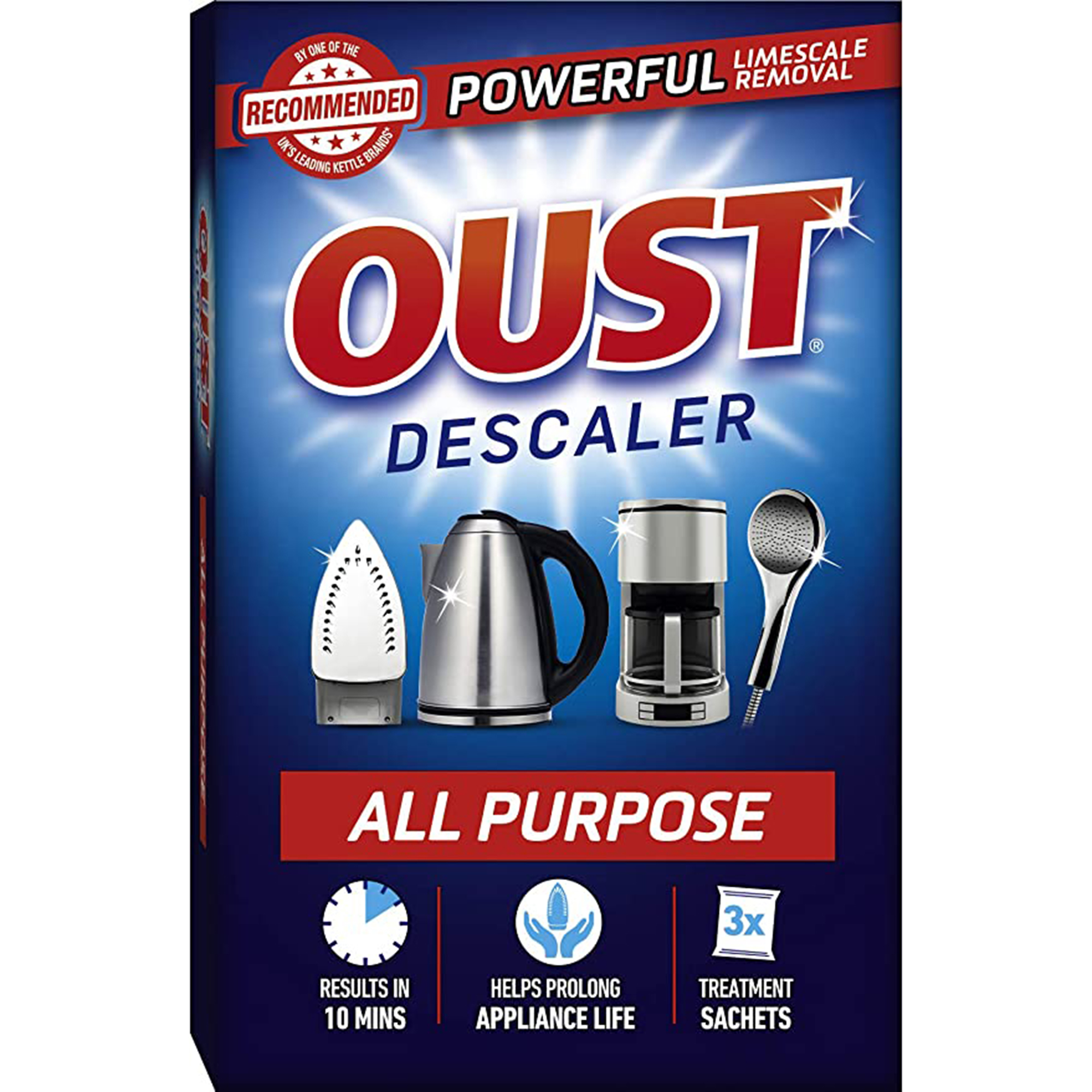
Type: Liquid
Size: 3x 0.9-ounce sachets
The exact stuff I used to demonstrate how to clean an electric kettle is available on Amazon. It has a light lemon scent and works in as little as 10 minutes. It can also be used to clean a clogged-up shower head, too.
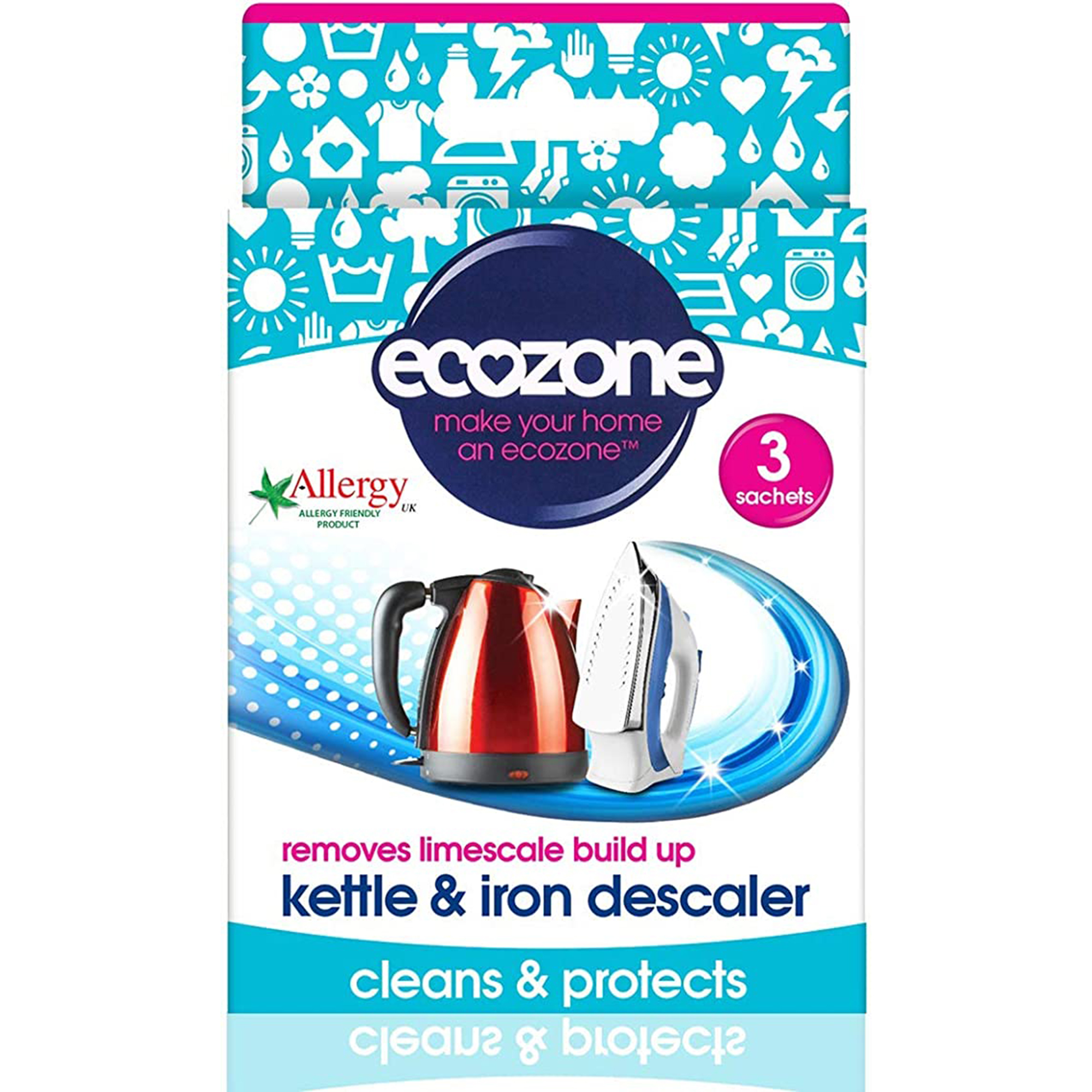
Type: Powder
Size: 3x 0.7-ounce packets
If you're after an eco-friendly cleaning product, then go for Ecozone's descaler, which is made with 100% citric acid. It takes half an hour to do its work, so you won’t be waiting long for a fur-free appliance. Oh, and it’ll clean up your steam iron and small coffee maker for you, too. It’s easy to use and, because it doesn’t take long, you won’t be parched for a hot drink.
How to descale a kettle with vinegar
We spoke with Clare Edwards, head of consumer and retail events at Smeg about the best way to descale a kettle.
"The most straightforward way to descale your kettle is by using a solution of vinegar or lemon mixed with water," she says. "Boil this mixture in your kettle and leave it to stand for a while to break down and remove limescale. Opting for a kettle with a removable limescale filter in its spout, like Smeg's, also make for simple cleaning."
Clean with acetic acid couldn't be easier using our step-by-step below.
- Fill the kettle up to ¾ capacity with a solution of equal parts water and white vinegar.
- Boil your kettle and then turn it off (if it doesn’t do so automatically) and allow the mixture to stay in the kettle for up to 30 minutes.
- Pour the liquid out after use, rinse out the kettle with fresh water, and then boil the kettle once or twice at full capacity to make sure that there is no lingering taste of vinegar.
How to clean an electric kettle with lemon juice
This method for cleaning your kettle is easy-peasy lemon squeezy. Since the juice of this yellow citrus fruit is so acidic, it will lift those crunchy bits of limescale with ease. If you don't want to use fresh lemons for cleaning, you can use bottled concentrate.
"I tend to buy the lemon juice from the cooking aisle in the supermarket that can be used for baking," says Lynsey Crombie, aka Lynsey Queen of Clean. "This is a less toxic way of de-scaling your kettle and you know that even if you did end up drinking the solution you are not going to come to any serious harm like I did a few years back [with commercial descaling solution]."
Helpful hint: If you're partial to Asian or Mexican recipes and are more likely to use limes when cooking, you can of course use this smaller green fruit instead. Grab a few from Amazon Fresh and get going within two hours of ordering!
- Try putting a mixture of 1 ounce of lemon juice to 16 ounces of water in your kettle.
- Leave it to stand for one hour before bringing boiling the liquid. Pour it out and rinse well before resuming your usual routine.
How to descale a kettle with baking soda
You can also use baking soda to clean if this is all you have on hand. Add a tablespoon of baking soda to a full kettle of water before boiling it. Allow it to stand for 15–30 minutes before pouring it out. Rinse the kettle with fresh water and boil once or twice with new water each time to ensure there is no lingering taste of baking soda.
Alternatively, you can make a paste using half a cup of baking soda and a few drops of water, then use a clean toothbrush to scrub off sections of limescale inside and out. Rinse well and boil the kettle a couple of times before the next use.
How to descale a kettle with cola
If you're wondering how to descale a kettle with Coke, know that it's one of the best options for doing so! This world-famous fizzy drink has a phosphoric acidity at a pH level of 2.8, which makes it as effective as lemon juice or vinegar for some cleaning tasks.
Pour enough cola (any brand will do) into your kettle to fill it and then set it to boil. After it has boiled, leave it to cool down for about 45 minutes before pouring it out. Thoroughly wash and rinse out your kettle afterward and boil some fresh water in it, discard it, and then you’ll be ready to make a cup of tea again.
How to descale a kettle with citric acid
You might have seen citric acid in the food or cleaning aisle and wondered what it's for. Well, it's used for adding a sour tang to dishes, preserving canned food, and —you guessed it — descaling a kettle.
While the term "acid" might sound scary, this is a non-toxic organic compound that's safe to use around young family members and pets. This four-step guide will take you through using this powdered product, which you can find on Amazon.
- Ensure that the kettle is half full before boiling it.
- Once it has boiled, add one to two tablespoons of citric acid powder to the boiled water.
- Allow the mixture to do its job for 15 to 20 minutes and then pour it out.
- Make sure that you rinse out the kettle and boil it at full capacity, throwing away the boiled water after and before you use it to make a hot drink.
How to descale a kettle with denture tablets
Even if your gnashers are all your own, you'll want to pick up some denture tablets (like these ones from Amazon) and get your teeth stuck into this kettle descaling hack. Depending on how much time you have on your hands (or your urgency for a brew), you can drop a tab or two in the kettle, fill it with water, leave it overnight and decant the contents in the morning.
Alternatively, boil the kettle straight after dispensing the tablets in the water and discard the solution. You can then proceed to make the perfect cup of tea, just how you like it.
FAQs
How to prevent limescale in a kettle
As well as regular cleaning, another top tip to keep your kettle clean is to empty and dry it with a microfiber cleaning cloth completely after each use, as leftover water left standing increases the chances of mineral deposits building up inside. To avoid wasting water, try and only fill your kettle with the amount of water you need, whether you're making tea or cooking pasta.
The same is true for the filters on the best boiling water taps and hot water dispensers — change them regularly to avoid build-up. Once you help to avoid the problem, the methods for how to descale a kettle are so much easier.
Otherwise, you could also buy a kettle scale collector (available from Amazon). This is essentially a small stainless steel mesh ball that will help save on energy bills and prolong the life of your kettle by trapping limescale ‘fur’ on its coils. It works by sitting inside the kettle and attracting limescale towards it, rather than the element or edges of your kettle — clever, right?
Is it OK to drink water with limescale?
In short, yes.... but it isn't pleasant. To explain, limescale (calcium carbonate) is a milky white, tough deposit that clogs up the filaments of your kettle and forms when hot water has evaporated and solidified. As well as looking unappetizing when it appears as flakes floating in your hot drink and giving your boiled water a slightly metallic tang to it, limescale can be stubborn to remove by scrubbing alone.
How often should you descale a kettle?
It’s important to clean your kettle every few months. Limescale and other mineral deposits build up inside your kettle over time and this will affect its performance, or even shorten its lifespan, so you’d be wise to pay it some attention occasionally. Not to mention, the cream-colored tartar looks super gross, god forbid a family member should take a peek inside your kettle if they've helped themselves to make coffee without a coffee maker.
"Understanding what your water hardness type is and how often you should descale your product, will massively improve the taste of your hot drinks and lengthen the lifespan of your appliance," says Debbie McIvor-Main, marketing manager at Dualit Ltd. "If you live in a soft water area, we recommend you descale your kettle every two months or every 100 cycles. If you live in a medium water area we recommend you descale your kettle once a month or every 50 cycles. And, if you live in a hard water area we recommend you descale your kettle at least once a month or every 25 cycles."
Meet our experts

From English Breakfast to Ceylon, Darjeeling, and chai, Christina loves tea. When she's not sipping from her favorite cup, she's flipping the switch to tee up her next brew. Builder's brew, no sugar, color-matched to her Asian-Med skin, please, and thank you. And by no means should the milk be added first, unless the tea has already been brewed in a teapot.
Having said that, once the working day is done, she likes to make a start on dinner and uses the kettle to fast-track the cooking process for rice and pasta dishes with boiled water (because who has time to wait for cold water to heat up?) In essence — her kettle gets a lot of action, so it's important she keeps it in tip-top condition.
Her descaler du jour is the Oust All Purpose Descaler which she uses in her kettle. The box contains three sachets of liquid, so she has no excuse for a congested teakettle.

Clare is Smeg’s head of consumer and retail events. With a degree in food and over 20 years’ experience as a home economist and training others in the kitchen, Clare has enormous expertise in cookery and deep knowledge of Smeg as a brand. Combined, Clare provides expert advice and training on how to get the most out of appliances, be that in the food they produce or how to care for them. Having won multiple awards for her training talents, Clare works alongside Smeg’s chef partners and presents the brands’ events and live cook-alongs, passing on her tips and tricks to customers. There’s not any wisdom about the kitchen that Clare doesn’t have readily available to pass on.
Join our newsletter
Get small space home decor ideas, celeb inspiration, DIY tips and more, straight to your inbox!

Hi, I'm the former acting head ecommerce editor at Real Homes. Prior to working for the Future plc family, I've worked on a number of consumer events including the Ideal Home Show, Grand Designs Live, and Good Homes Magazine. With a first class degree from Keele University, and a plethora of experience in digital marketing, editorial, and social media, I have an eye for what should be in your shopping basket and have gone through the internal customer advisor accreditation process.
-
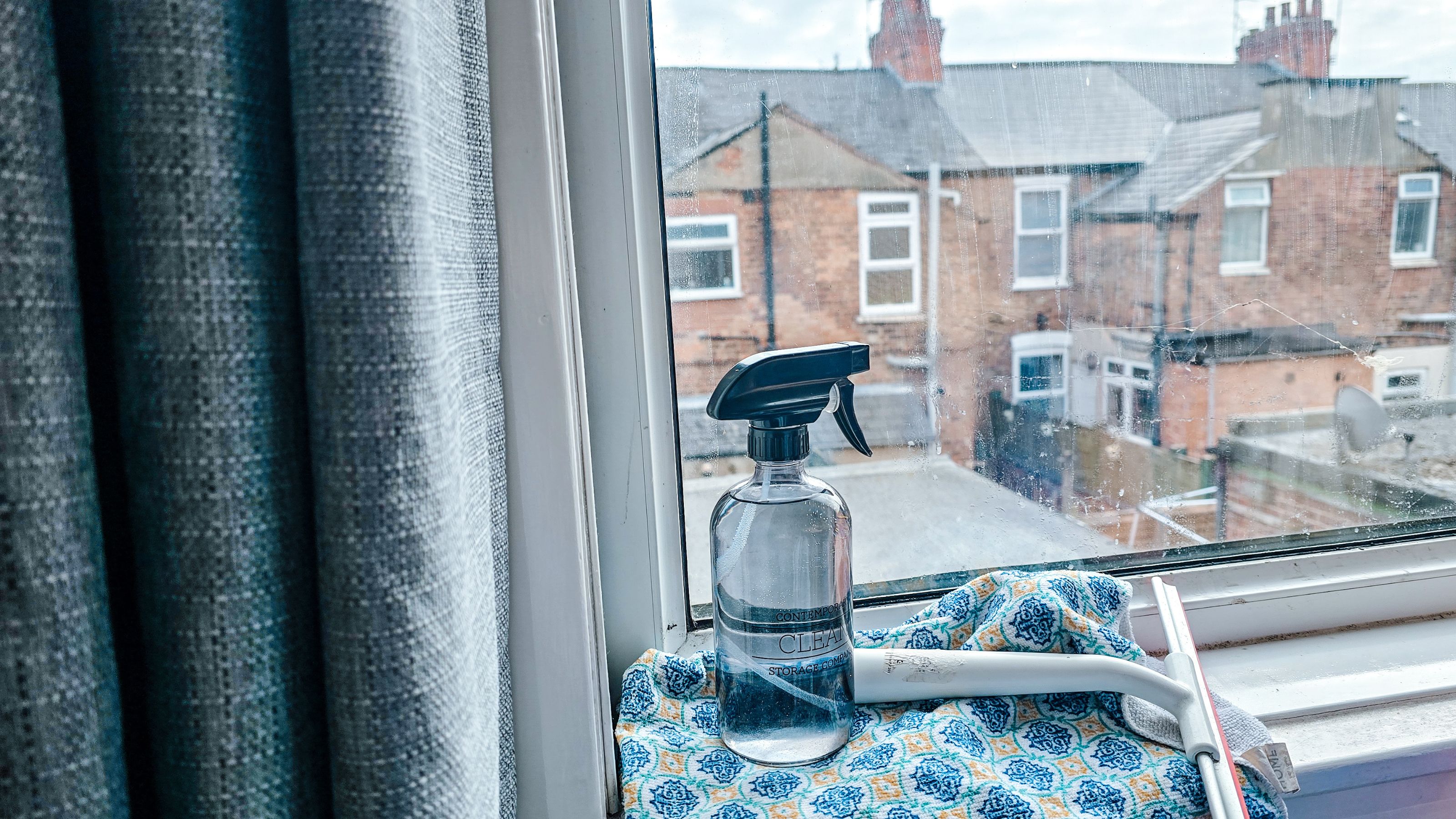 How to clean windows without streaks — 5 easy steps that cleaning pros always follow
How to clean windows without streaks — 5 easy steps that cleaning pros always followThis method on how to clean windows is favored by professional cleaners. We've asked them for the steps you should follow, plus picked cleaning buys
By Eve Smallman
-
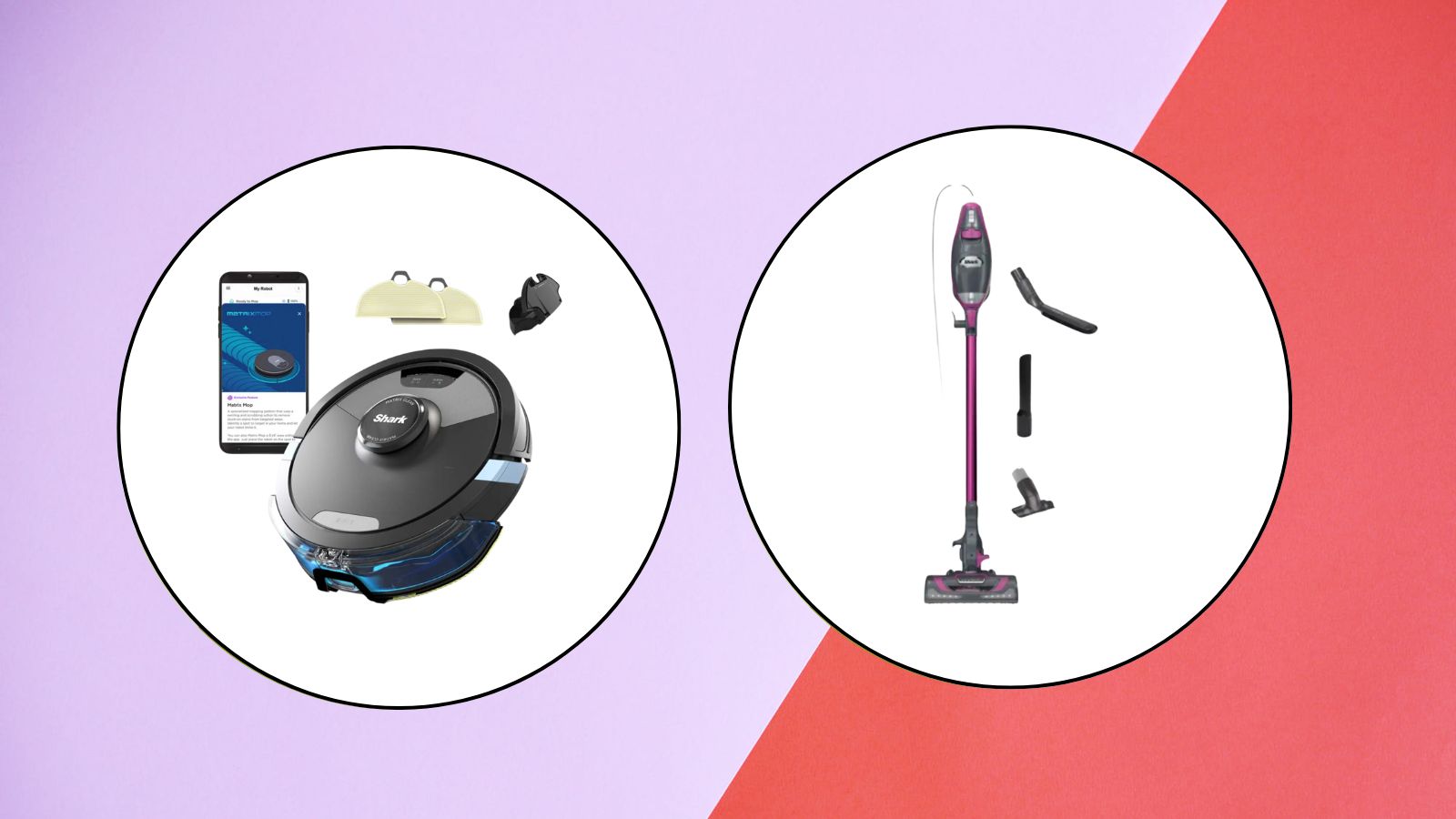 The latest Shark sale deals are perfect for pollen-proofing your home — with up to $150 off our favorite vacuums
The latest Shark sale deals are perfect for pollen-proofing your home — with up to $150 off our favorite vacuumsWe found the latest Shark sale deals on vacuums that are sure to be swooped up, especially as spring blooms trigger pollen allergies and we're in need of extra cleaning
By Danielle Valente
-
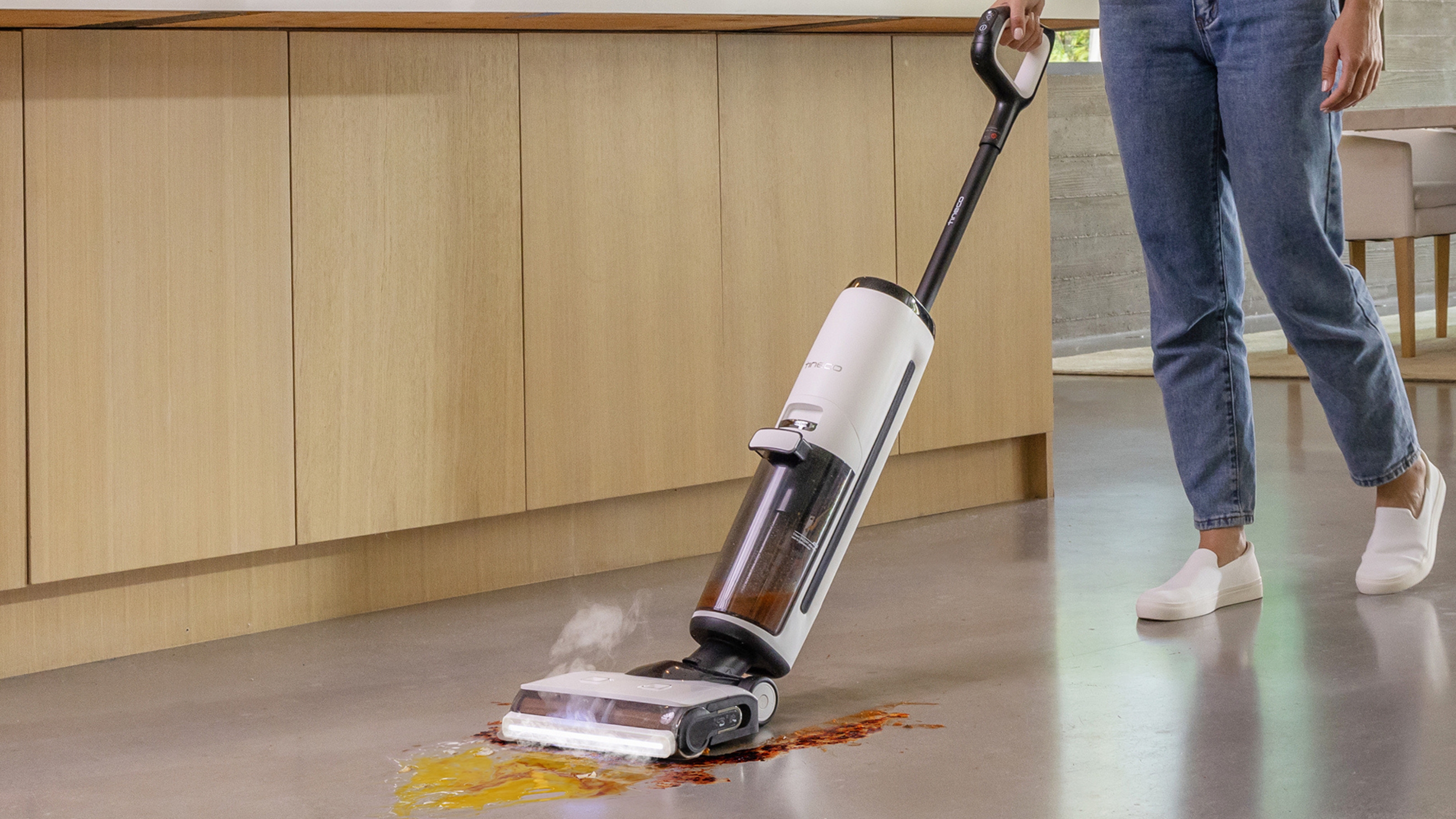
 Tineco Floor One S7 steam wet-dry vacuum review — spotless floors with minimal effort
Tineco Floor One S7 steam wet-dry vacuum review — spotless floors with minimal effortOur contributing editor, Camryn Rabideau, tests the Tineco Floor One S7 steam wet-dry vacuum in her New England homestead property
By Camryn Rabideau
-
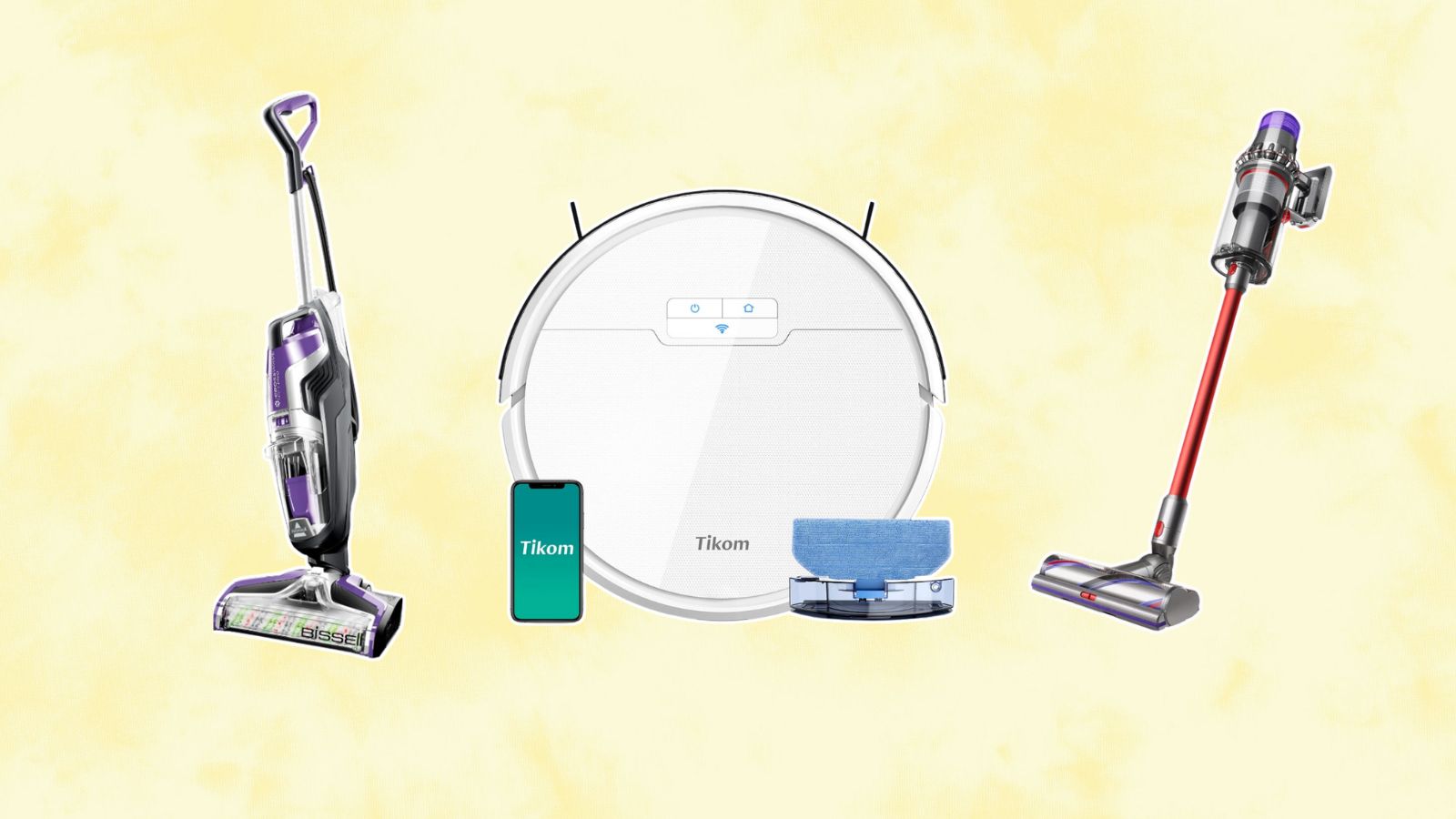 Amazon vacuum cleaners to nab during the retailer's Big Spring Sale — save up to 60% off our go-to small-space finds
Amazon vacuum cleaners to nab during the retailer's Big Spring Sale — save up to 60% off our go-to small-space findsChecking out the savings on Amazon? Vacuum cleaners are a must-buy during their first Big Spring Sale — here are our favorites up to 60% off
By Danielle Valente
-
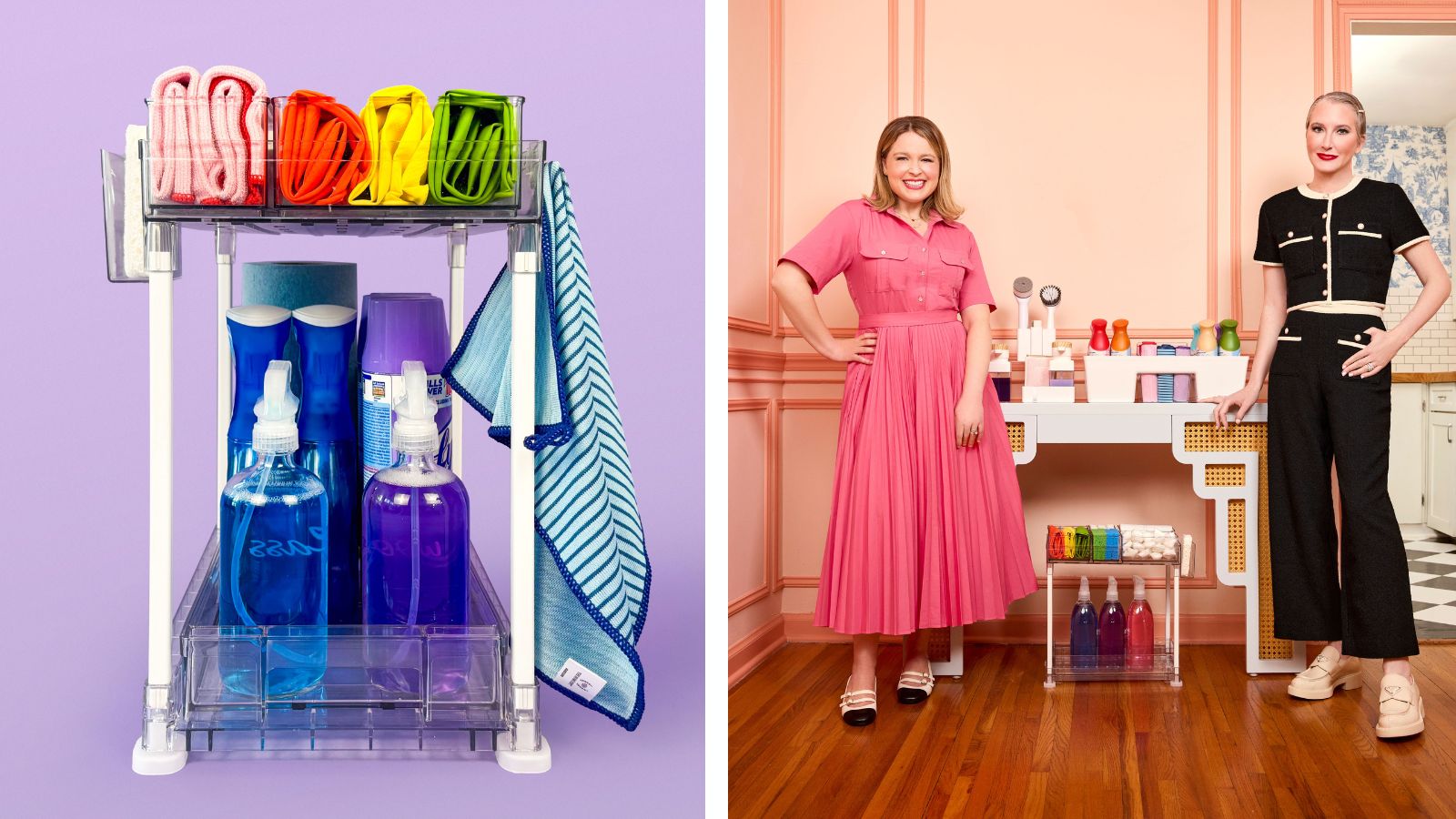 The Home Edit Walmart cleaning collection has just debuted with finds from $3
The Home Edit Walmart cleaning collection has just debuted with finds from $3Spring cleaning, anyone? The Home Edit Walmart cleaning collection has hit shelves with picks from $3
By Danielle Valente
-
 How to clean carpet on stairs — 3 simple steps to a spruced up staircase
How to clean carpet on stairs — 3 simple steps to a spruced up staircaseWant to know how to clean carpet on stairs? Our experts explain the simple steps to a sparkling stairway without too much elbow grease
By Andy van Terheyden
-
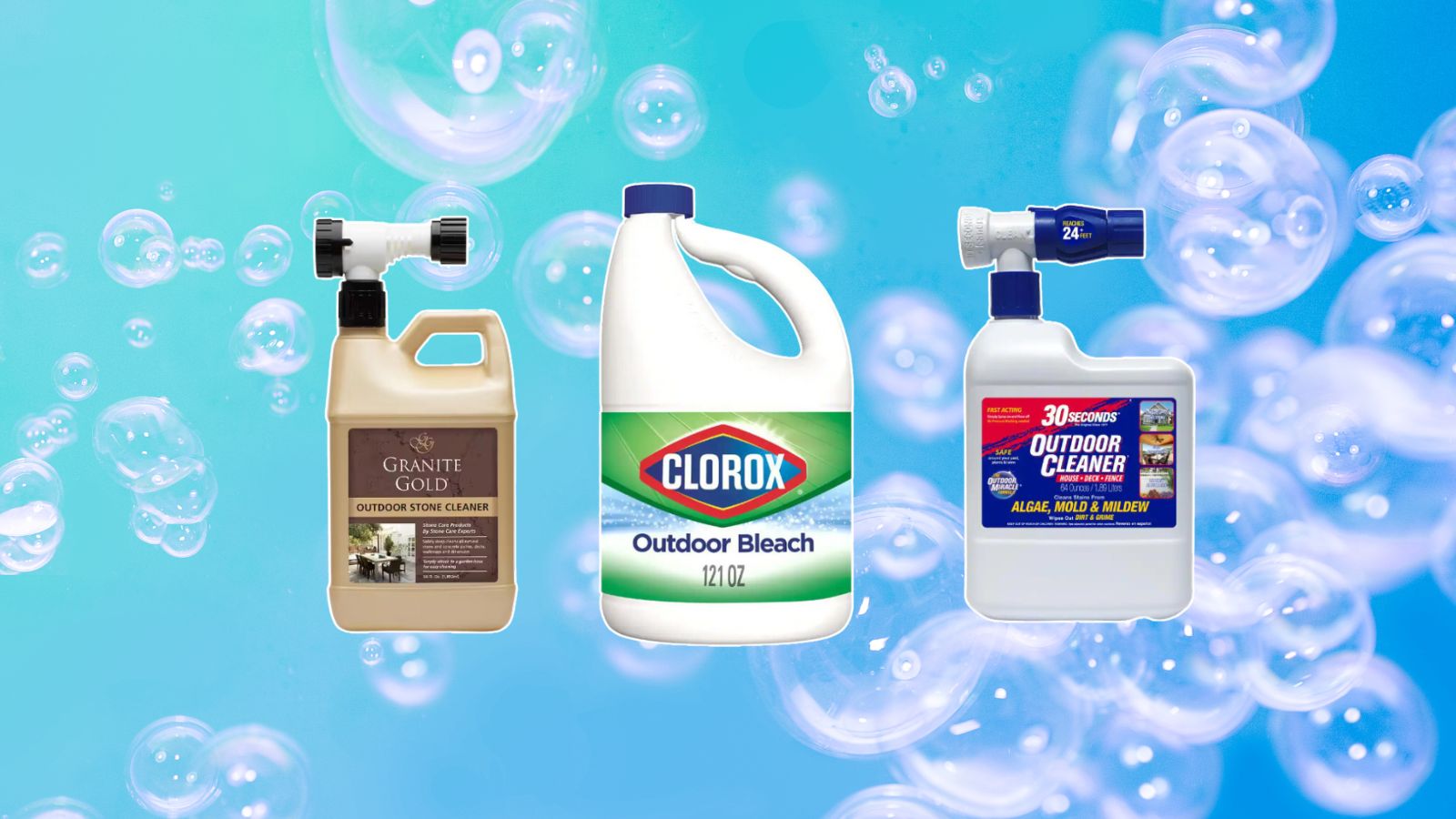 The Home Depot backyard and patio cleaning supplies we're stocking up on before spring
The Home Depot backyard and patio cleaning supplies we're stocking up on before springDon't forget the outdoors when spring cleaning — The Home Depot backyard and patio cleaning buys from $11 will assist with tidying up
By Danielle Valente
-
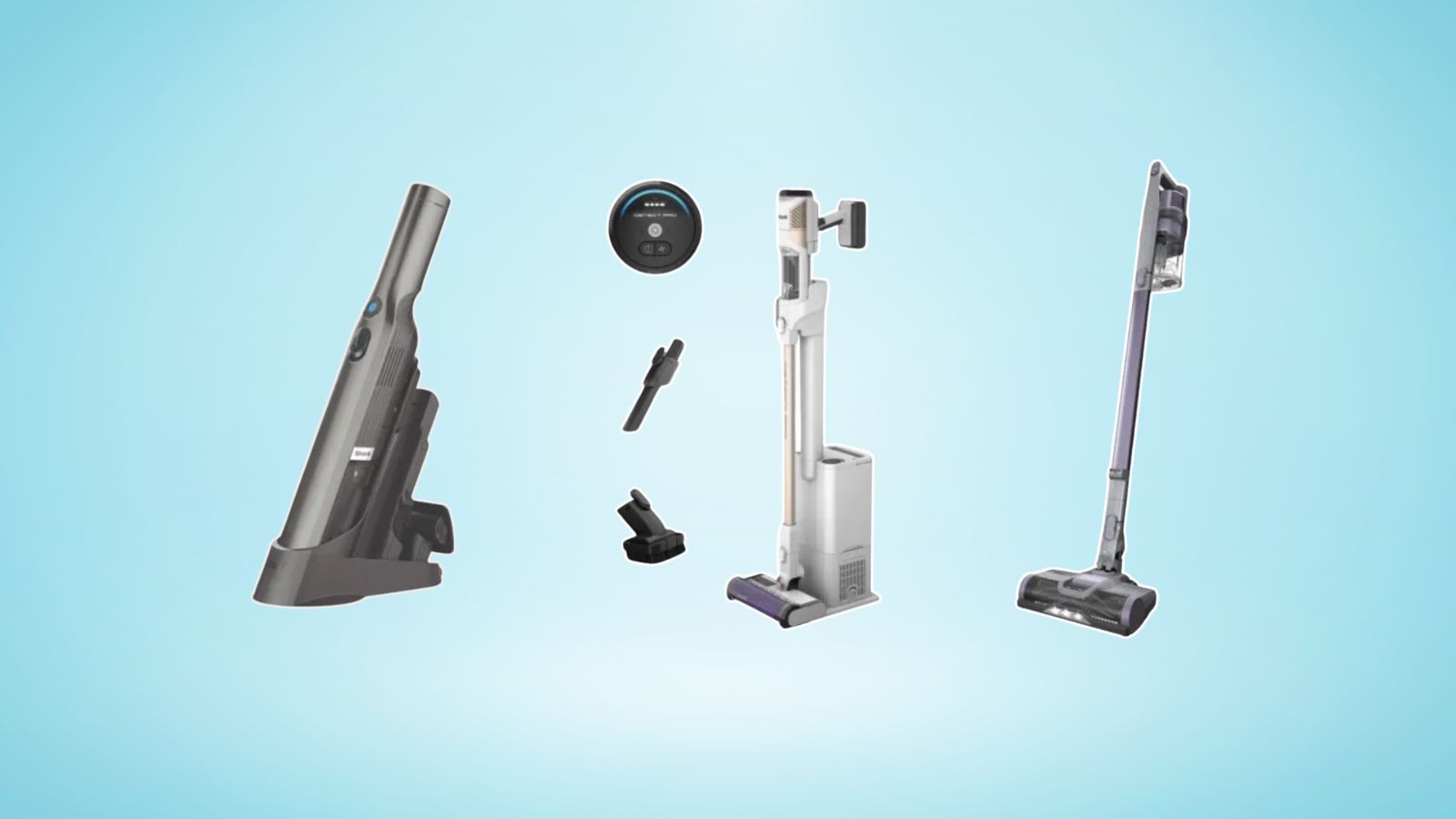 The Shark Detect Pro vacuum and other models are on sale for St Patrick's Day — perfect picks for your spring clean
The Shark Detect Pro vacuum and other models are on sale for St Patrick's Day — perfect picks for your spring cleanWhether you're eyeing the Shark Detect Pro Vacuum or Shark Pet Cordless Stick Vacuum, shop the St. Patty's Day sale for a discount on the best vacuums on shelves
By Danielle Valente